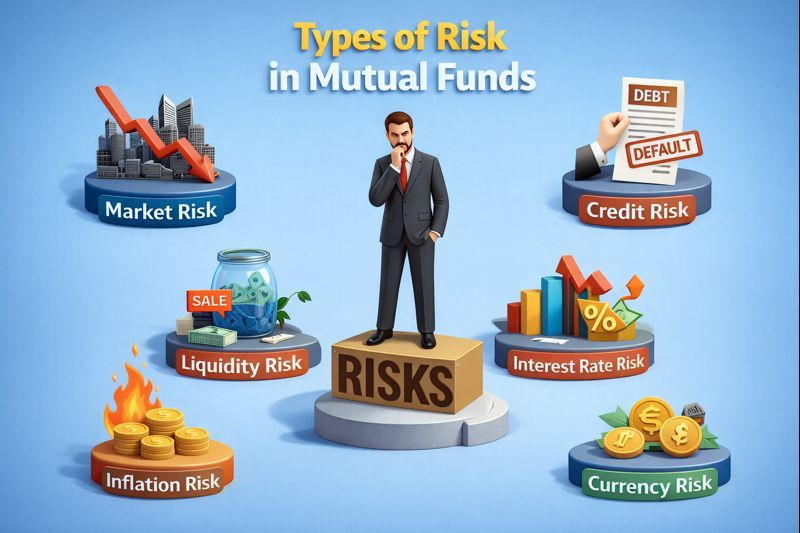- Home
- Blog
- Mutual Funds
- Types of Risk in Mutual Funds: What Every Investor Should Know
- Types of Risk in Mutual Funds: What Every Investor Should Know
Types of Risk in Mutual Funds: What Every Investor Should Know

- Published Date: December 16, 2025
- Updated Date: December 16, 2025
- By Team Choice
Mutual funds are among the most accessible ways to grow wealth, but every investment comes with risk. To make confident decisions, it’s essential to understand the types of risk in mutual funds and how they impact your actual returns. All these risks eventually show up as changes in a fund’s Net Asset Value (NAV) - the per-unit value of your investment.
In this guide, you’ll learn how different mutual fund categories carry different levels of risk, the 10 major risks associated with mutual funds, and practical ways to manage them as a beginner.
Different Mutual Fund Types and Risks They Carry
Before selecting a mutual fund, it’s important to understand that each category exposes your money to different types of risks:
1. Equity Mutual Funds: Equity mutual funds invest mainly in stocks of companies. They offer the highest long-term growth potential but also experience higher short-term fluctuations. These funds are best suited for investors with a long investment horizon of five years or more, as this allows them to ride out market volatility and benefit from compounding.
Key Risks:
- Market Volatility: Equity funds are heavily influenced by market movements. Economic changes, geopolitical events, corporate earnings, and investor sentiment can cause your NAV to rise or fall significantly in the short term.
- Sector & Style Risk: Funds with a strong focus on a sector (like IT or banking) or style (like mid-cap or small-cap) are more vulnerable to fluctuations in those areas. Small-cap and mid-cap funds, in particular, can deliver high returns but are more prone to sharp corrections.
- Company-Specific Risk: A fund's performance depends on the success of the companies it invests in. Poor management decisions, weak governance, or financial underperformance can negatively impact the fund’s NAV.
- Currency Risk (For International Equity Funds): Investors now commonly diversify into global equity funds. These funds carry currency risk, meaning the NAV can fluctuate due to changes in foreign exchange rates, independent of market performance. For example, if the rupee strengthens against the dollar, your international fund may fall in value even if global markets perform well.
2. Debt Mutual Funds: Debt mutual funds invest in fixed-income instruments such as government securities, corporate bonds, commercial papers, and treasury bills. They are considered more stable than equity funds, but the risks within debt funds are often misunderstood by beginners.
Key Risks:
- Interest Rate Risk: One of the most important concepts in debt investing is the well-known inverse relationship between interest rates and bond prices.
- When interest rates rise, bond prices fall, reducing NAV.
- When interest rates fall, bond prices rise, increasing NAV.
The duration of a debt fund indicates how sensitive the fund is to changes in interest rates. Long-duration funds react more sharply to interest rate movements. Short-duration funds exhibit less volatility.
- Credit Risk: Debt funds carry the risk that a bond issuer may default or delay payments. This risk is measured using credit ratings, such as AAA (highest safety), AA, A, BBB, etc.
High-yield or “junk” bonds (usually rated below investment grade) offer higher interest rates to compensate for higher default risk. Beginners chasing unusually high returns in debt funds often unknowingly take on this elevated credit risk.
- Liquidity Risk: Some bonds, particularly lower-rated or privately placed ones, may not have enough buyers during times of market stress. If the fund needs to sell these securities but cannot find buyers, NAV and redemption timelines may be affected.
- Yield Volatility: Debt fund returns fluctuate based on economic cycles, interest rate movements, and credit conditions. While more stable than equities, they are not risk-free.
3. Hybrid Mutual Funds: Hybrid mutual funds invest in a mix of equity, debt, and sometimes other assets like gold. They aim to deliver balanced performance by blending growth potential with stability. They are suitable for investors seeking moderate risk.
Key Risks:
- Asset Allocation Risk: The performance of a hybrid fund depends on the proportion of equity and debt. During equity downturns or interest rate hikes, the NAV may fluctuate depending on how the fund is allocated.
- Dynamic Allocation Volatility: Some hybrids frequently change their allocation (like dynamic or balanced advantage funds). While this aims to reduce risk, it can cause short-term NAV volatility.
- Misalignment With Investor Profile: Not all hybrid funds fit every investor. A conservative investor might unintentionally pick a more equity-heavy hybrid fund, increasing exposure to stock market fluctuations. Meanwhile, aggressive investors might select a debt-heavy hybrid fund, reducing potential returns.
- Taxation Risk: Taxation on hybrid funds depends heavily on the equity proportion.
- If the fund maintains 65% or more equity, it receives equity taxation, which is typically more favourable (STCG taxed at 20% and LTCG taxed at 12.5%).
- If equity falls below 65%, it is taxed as a debt fund, meaning gains may be taxed at your income slab rate, which could be significantly higher.
Beginners often overlook this, but taxation can meaningfully impact long-term wealth creation.
10 General Risks Across All Mutual Funds
Regardless of whether you invest in equity, debt, or hybrid funds, all mutual funds carry certain universal risks. Understanding these helps you become a more informed investor and prevents surprises when markets fluctuate.
1. Market Risk (Systematic Risk):
This is the risk of the entire market declining due to macroeconomic events like recessions, pandemics, inflation spikes, geopolitical conflicts, or global slowdowns.
It affects almost all assets, equity, debt, and commodities, and cannot be diversified away. Even the best-managed funds experience NAV declines during broad market downturns.
2. Interest Rate Risk:
Most relevant for debt and hybrid funds, interest rate risk arises from the inverse relationship between bond prices and interest rates. When interest rates rise, bond prices fall, leading to drops in NAV. When interest rates fall, bond prices rise, leading to a rise in NAV.
Funds holding longer-duration bonds are more sensitive to rate changes. Beginners should always check a debt fund’s duration to gauge how volatile it might be in different interest rate environments.
3. Credit Risk:
This risk arises when a bond issuer is unable to repay the principal or meet interest obligations. Debt funds contain multiple bonds, each rated for safety using credit ratings like:
- AAA – Highest quality, lowest risk
- AA / A – Moderate risk
- BBB and below – Higher risk, sometimes called high-yield or junk bonds
Chasing very high returns in debt funds usually means taking on higher credit risk.
4. Liquidity Risk:
This is the risk that a fund may not be able to sell a security quickly enough when investors redeem their units. Illiquid securities, often lower-rated corporate bonds or niche assets, can cause delays, affect NAV, or force the fund to sell other liquid assets at unfavourable prices. Liquidity becomes especially important during market stress or panic situations.
5. Inflation Risk (Real Rate of Return Risk):
If inflation rises faster than your investment returns, your purchasing power decreases. Your true wealth growth is actually your real rate of return:
Real Return = Nominal Return – Inflation
Funds generating 6% returns in a 7% inflation environment are effectively causing a 1% loss in purchasing power.
6. Concentration Risk (Unsystematic Risk):
When a fund invests heavily in one sector, theme, or asset class, a decline in that segment can significantly impact returns. This is known as unsystematic risk, and it can be reduced through diversification. Sectoral, thematic, small-cap, and focused funds carry higher concentration risk.
7. Currency Risk:
Funds with international exposure (global equity or global debt funds) face currency fluctuations. If the Indian rupee strengthens against a foreign currency (like the USD), the NAV of your international fund can fall, even if the foreign markets are performing well. Conversely, a weakening rupee may boost returns.
8. Fund Manager Risk:
Mutual funds are professionally managed, but the fund’s performance depends on the fund manager’s:
- Strategy
- Experience
- Ability to respond to market changes
- Risk management skill
Poor decisions, excessive churn, or misjudging market conditions can negatively impact returns.
9. Expense Ratio Risk:
Every mutual fund charges an expense ratio to manage your investment. This fee directly reduces your returns. Higher expense ratios → Lower take-home returns. In long-term wealth creation, even a 0.5% difference compounds significantly. Passive (index) funds generally have lower expense ratios than actively managed funds.
10. Regulatory Risk:
Changes in government policies, taxation rules, market regulations, or SEBI guidelines can affect the performance of funds. For example:
- A change in capital gains tax rules
- Re-categorisation of mutual funds by SEBI
- New limits on sector exposure
Such changes may alter fund strategy, returns, or tax implications for investors.
Practical Ways to Reduce the Risks Involved in Mutual Fund Investments
Here are the most practical ways to reduce the risks involved in investing in mutual funds and build a stable, goal-aligned portfolio:
1. Leverage SIPs to Reduce Volatility:
A Systematic Investment Plan (SIP) helps you invest a fixed amount regularly, weekly, monthly, or quarterly. Through Rupee-Cost Averaging, an SIP automatically buys:
- More units when the NAV is low
- Fewer units when the NAV is high
This reduces the impact of short-term market fluctuations and helps beginners stay invested without trying to time the market.
2. Use STPs for Safer Transitions Between Funds:
A Systematic Transfer Plan (STP) allows you to move money gradually from one fund to another, typically from a debt fund to an equity fund. This is ideal for:
- Mitigating timing risk
- Investing lump sums safely
- Entering equity markets during volatile or uncertain periods
It ensures smoother entry and avoids sudden NAV shocks.
3. Diversify Across Asset Classes:
Diversification reduces unsystematic risk by spreading investments across equity, debt, gold, and hybrid categories. A diversified portfolio ensures that when one asset class underperforms, another can help balance overall returns.
4. Match Investment Type to Your Time Horizon:
Choosing funds based on your goal duration is one of the most effective ways to reduce risk:
- Long-term goals (5+ years): Equity funds
- Medium-term goals (3–5 years): Hybrid funds
- Short-term goals (1–3 years): Debt funds
- Ultra-short-term needs (< 1 year): Liquid or ultra-short duration funds
When your horizon aligns with the fund type, temporary volatility becomes manageable.
5. Assess Credit Quality in Debt Funds:
If you invest in debt funds, always examine the credit ratings of the bonds in the portfolio. Prefer funds with:
- Higher-rated bonds (AAA / AA) for stability
- Lower exposure to high-yield, low-rated (junk) bonds unless you understand the risks
High returns in debt funds often indicate higher credit risk, something beginners must be careful about.
6. Monitor the Fund’s Duration:
For debt funds, duration is the key measure of sensitivity to interest rate changes.
- Short-duration funds: Less sensitive → Lower interest rate risk
- Long-duration funds: More sensitive → Higher interest rate risk
Beginners generally benefit from short- or medium-duration funds unless they fully understand rate cycles.
7. Keep an Eye on Expense Ratios:
The expense ratio directly impacts your returns. A lower expense ratio means less money deducted from your profits and better long-term compounding. Passive index funds often attract beginners; for this reason, they offer solid returns at minimal cost.
8. Review Your Portfolio Regularly:
Markets evolve, personal goals change, and your investments should adapt accordingly.
Review your portfolio:
- Every 6–12 months
- During major market changes
- When your financial goals shift
Rebalancing ensures your allocation stays aligned with your risk profile.
9. Understand Tax Implications Before Investing:
Taxation changes your actual take-home return.
- Equity-oriented funds generally enjoy lower long-term taxes.
- Debt-oriented funds follow slab-based taxation.
- Hybrid funds depend on their equity proportion (usually 65%+ for equity taxation).
Knowing this helps you pick the most tax-efficient fund for each goal.
10. Stick to Your Risk Profile:
Whether you’re conservative, moderate, or aggressive, your investments should reflect your comfort with volatility. A risk assessment or a basic questionnaire from an AMC or investment platform can help you determine:
- How much equity can you realistically handle
- Whether hybrid or debt funds are more suitable
- What proportion of your portfolio should be in safe instruments
Investing in funds beyond your risk tolerance often leads to panic selling.
11. Choose Funds With a Strong Track Record:
A fund’s history doesn’t guarantee future returns, but it does reveal how well the fund manager handled past market cycles. Check for consistency, stable risk-adjusted returns, long-term performance across bull and bear markets, and portfolio quality. Avoid funds that appear frequently in the “top performer” list but lack long-term reliability.
12. Avoid Emotional or Impulse-Based Investing:
Beginner investors often exit during downturns or enter at peaks due to fear or excitement. Long-term investing requires discipline:
- Don't chase returns
- Don't panic on dips
- Stick to your plan
- Review rationally
Patience is one of the strongest risk-management tools.
Conclusion
Understanding the different types of risk in mutual funds helps you make informed choices and build a portfolio aligned with your financial goals. While risks associated with mutual funds are unavoidable, they can be managed smartly through diversification, disciplined investing, and careful fund selection. With the right approach, mutual funds remain one of the most effective tools for long-term wealth creation, allowing you not to avoid risk, but to intelligently deploy it to achieve your financial freedom.
Recommended for you

Currency Derivatives

Copper Price Forecast for Next Week

Share Market Prediction For Tomorrow
